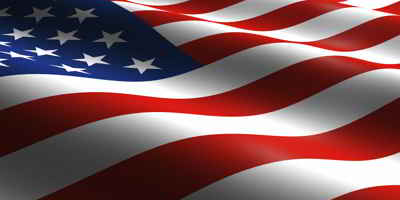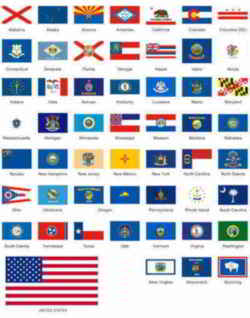

Tennessee Symbols
Tennessee State
Flag
Adopted on April 17, 1905.
The state flag of Tennessee was adopted on April 17, 1905 by an act of the Legislature. The flag of the state of Tennessee consists of an emblem on a field of red, with a strip of blue on the fly. The emblem of the middle consists of three stars on a blue circle. The flag was designed by Colonel LeRoy Reeves of the Tennessee National Guard. The Tennessee State Legislature officially adopted the flag on April 17, 1905. The flag was first raised on October 10, 1911, during the dedication ceremonies for East Tennessee State Normal School in Johnson City. The central emblem portion of the flag appears in the logos of some Tennessee-based companies and sports teams. Examples include the First Tennessee Bank, Tennessee Titans of the National Football League and the Nashville Predators of the National Hockey League.
The Tennessee State Flag
TheTennessee state flag was designed by LeRoy Reeves of the Third Regiment, Tennessee Infantry, who made the following explanation of his design:
Flag of Tennessee Artist's Original Sketch TENNESSEE BLUE BOOK 494: The three stars are of pure white, representing the three grand divisions of the state. They are bound together by the endless circle of the blue field, the symbol being three bound together in one - an indissoluble trinity. The large field is crimson. The final blue bar relieves the sameness of the crimson field and prevents the flag from showing too much crimson when hanging limp. The white edgings contrast more strongly the other colors.
This flag was adopted as the official flag of the State of Tennessee by an act of the Legislature passed and approved April 17, 1905. The design of the flag was described by that act, Chapter 498 of the Public Acts of 1905, as follows:
An oblong flag or banner in length one and two thirds times its width, the large or principal field of same to be of color red, but said flag or banner ending at its free or outer end in a perpendicular bar of blue, of uniform width, running from side to side; that is to say, from top to bottom of said flag or banner, and separated from the red field by a narrow margin or stripe of white of uniform width; the width of the white stripe to be one-fifth that of the blue bar; and the total width of the bar and stripe together to be equal to one-eighth of the width of the flag. In the center of the red field shall be a smaller circular field of blue, separated from the surrounding red field by a circular margin or stripe of white of uniform width and of the same width as the straight margin or stripe first mentioned. The breadth or diameter of the circular blue field, exclusive of the white margin, shall be equal to one-half of the width of the flag. Inside the circular blue field shall be three five-pointed stars of white distributed at equal intervals around a point in the center of the blue field and shall be of such size and arrangement that one point of each star shall approach as closely as practicable without actually touching one point of each of the other two around the center point of the field; and the two outer points of each star shall approach as nearly as practicable without actually touching the periphery of the blue field. The arrangement of the three stars shall be such that the centers of no two stars shall be in a line parallel to either the side or end of the flag, but intermediate between same; and the highest star shall be the one nearest the upper confined corner of the flag.
Flag of the General Assembly
 The
flag of the General Assembly was adopted by the 90th General Assembly in 1978. The banner
was designed by art and design student Sheila Adkins, a student at Knoxville's Fulton High
School. Her design was chosen from among those submitted by numerous students from across the
state. The designer chose white for purity, blue to denote respect for Tennessee, red as the
traditional color for America; stars to symbolize the state's three Grand Divisions; wheat
for agricultural heritage; and the gavel for the power of the people vested in the state's
legislative body.
The
flag of the General Assembly was adopted by the 90th General Assembly in 1978. The banner
was designed by art and design student Sheila Adkins, a student at Knoxville's Fulton High
School. Her design was chosen from among those submitted by numerous students from across the
state. The designer chose white for purity, blue to denote respect for Tennessee, red as the
traditional color for America; stars to symbolize the state's three Grand Divisions; wheat
for agricultural heritage; and the gavel for the power of the people vested in the state's
legislative body.
Official Flag for the Governor
 No
act has been passed by the General Assembly establishing an official flag for the governor,
but in 1939, at the request of the adjutant general, one was designed by the US War Department.
The central design on the flag is the crest of the National Guard of Tennessee, which is described
in a letter from the secretary of war, dated May 28, 1923, as:
No
act has been passed by the General Assembly establishing an official flag for the governor,
but in 1939, at the request of the adjutant general, one was designed by the US War Department.
The central design on the flag is the crest of the National Guard of Tennessee, which is described
in a letter from the secretary of war, dated May 28, 1923, as:
...on a wreath argent and gules, upon amount vert a hickory tree properly charged with three mullets one and two argent, the description of which is as follows: The state of Andrew Jackson - "Old Hickory"- Tennessee, was the Sixteenth state admitted to the union, the original 13 plus 3, and the state flag bears three white stars. The predominant original white population within the state was of English origin, and the twists of the wreath are accordingly white and red. This design was placed upon a red background in the corners of which are placed a 5-pointed star representing the fact that the governor of the state by virtue of his office automatically becomes commander in chief of the National Guard of that state.
The first paragraph means that on a wreath of silver (or white) and red is a green hill upon which is a hickory tree bearing three five-pointed stars, each one separated from the other two, and all three silver (or white).
Tennessee Flag Law
Tennessee Code, Title 4, Chapter 1.
Title 4 State Government
Chapter 1 General Provisions
Part 3 State Symbols
4-1-301. State flag or banner.
(a)The flag or banner of this state shall be of the following design, colors and proportions,
to wit: an oblong flag or banner in length one and two thirds (12/3) times its width, the principal
field of same to be of color red, but the flag or banner ending at its free or outer end in
a perpendicular bar of blue, of uniform width, running from side to side, that is to say, from
top to bottom of the flag or banner, and separated from the red field by a narrow margin or
stripe of white of uniform width; the width of the white stripe to be one fifth (1/5) that
of the blue bar; and the total width of the bar and stripe together to be equal to one eighth
(1/8) of the width of the flag. In the center of the red field shall be a smaller circular
field of blue, separated from the surrounding red field by a circular margin or stripe of white
of uniform width and of the same width as the straight margin or stripe first mentioned. The
breadth or diameter of the circular blue field, exclusive of the white margin, shall be equal
to one half (1/2) of the width of the flag. Inside the circular blue field shall be three (3)
five-pointed stars of white distributed at equal intervals around a point, the center of the
blue field, and of such size and arrangement that one (1) point of each star shall approach
as closely as practicable without actually touching one (1) point of each of the other two
(2) around the center point of the field; and the two (2) outer points of each star shall approach
as nearly as practicable without actually touching the periphery of the blue field. The arrangement
of the three (3) stars shall be such that the centers of no two (2) stars shall be in a line
parallel to either the side or end of the flag, but intermediate between same; and the highest
star shall be the one nearest the upper confined corner of the flag.
(b)(1)It is an offense to knowingly manufacture or sell a state flag that is not in compliance
with subsection (a).
(2)The provisions of this subsection (b) shall apply only to flags that are manufactured, sold
or offered for sale as official state flags and shall not apply to miniature flags or flags
manufactured, sold or offered for sale as souvenirs, novelties, decorations or toys.
(3)A violation of this subsection (b) is considered a deceptive business practice and punishable
as provided in § 39-14-127.
(c)(1)Each Tennessee state flag manufactured or otherwise produced shall have imprinted on
the flag a legend or other markings, or both, sufficient to clearly indicate the proper manner
in which to fly or otherwise display the Tennessee state flag.
(2)The purpose of this subsection (c) is to ensure that the public does not fly or otherwise
display the Tennessee state flag in any incorrect manner, especially not upside down.
(3)For the purposes of this subsection (c), "Tennessee state flag"includes all
flags that are manufactured, sold or offered for sale as official state flags.
(d)All official flags of the United States and of the state of Tennessee, purchased under a
state contract, shall be manufactured in the United States.
[Acts 1905, ch. 498; Shan., § 92a1; Code 1932, § 101; T.C.A. (orig. ed.), § 4-106; Acts 1990,
ch. 1059, § 1; 2000, ch. 640, § 1; 2005, ch. 497, § 1.]
Title 4 State Government
Chapter 1 General Provisions
Part 3 State Symbols
4-1-329. Official salute to the Tennessee flag.
(a)The following salute written by Lucy Steele Harrison is designated and adopted as the first
official salute to the flag of Tennessee:
"Three white stars on a field of blue
God keep them strong and ever true
It is with pride and love that we
Salute the Flag of Tennessee."
(b)The following salute written by Miss John Bostick is designated and adopted as the second
official salute to the flag of Tennessee:
"Flag of Tennessee, I salute thee
To thee I pledge my allegiance with
My affection, my service and my life."
[Acts 2006, ch. 841, § 1.]

The Flags of the US.





